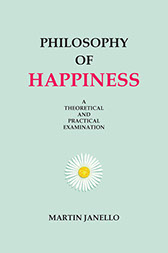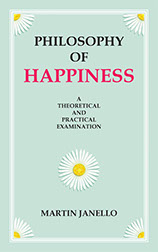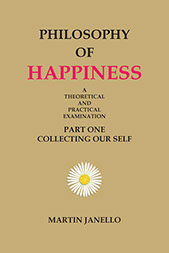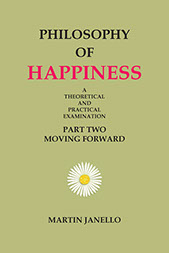
I. OUR SEARCH FOR HAPPINESS
Happiness. We spend our life and all our efforts in its pursuit. Yet do we really know what it is and how it occurs? Are we secure in how to achieve and maintain it? Are we certain that we are maximizing our potential to obtain it? Our answers to these questions may not be as firm as we would like them to be. Nor may we ask such probing questions. Life rushes by in and around us, and we are trying to make the best of it. But what is that best and how can we best achieve it? The principles and strategies we produce or receive from others may not provide the happiness they promise or we desire. We may be able to blame interference or seemingly unchangeable circumstances as causes for this shortfall. But we may also sense that our lack of insight arrests our happiness at levels short of its potential. We may be looking for the meaning of life in general or for a meaningful life for us in particular. We may also be dissatisfied with much more narrowly defined circumstances for reasons we do not entirely understand. We may search, often not even knowing what we are looking for.
244x325.jpg?crc=3925019415) The reasons for our struggle are obvious. The pursuit and maintenance of our happiness are as complex as our life. As long as we live, there are facts, possibilities, and impressions of both that can influence our happiness. These come in a myriad of shapes, combinations, and settings. Some of these circumstances can be known, and some can be affected by us. But much remains beyond our mind's grasp or more obviously physical capabilities.
The reasons for our struggle are obvious. The pursuit and maintenance of our happiness are as complex as our life. As long as we live, there are facts, possibilities, and impressions of both that can influence our happiness. These come in a myriad of shapes, combinations, and settings. Some of these circumstances can be known, and some can be affected by us. But much remains beyond our mind's grasp or more obviously physical capabilities.
We all know this and ask how much happiness we can possibly experience in this world. We further ask what we can do to positively influence our existence. Our answers or the lack thereof form important parts of our philosophy of happiness and may dramatically influence our mindset and behavior. They engender subjective conditions that may impact our happiness as much as objective conditions. It is therefore crucial that we correctly understand the terms of our happiness in their limitations and potentials and keep developing and adjusting corresponding strategies that maximize our chances. However, before we can proceed to such resolutions, we must determine more fundamentally what makes us happy and unhappy so we possess proper objectives and markers in our plans and activities. Our findings in these respects form the underlying portion for our philosophy of happiness.
.jpg?crc=4224704736)
When we proceed to such considerations, we soon realize that happiness is not uniform. We see different kinds of happiness we pursue or seek to keep and that these objectives and their pursuits may compete with one another in technical measures and resulting effects. We also experience that happiness is a fleeting emotion and that it requires a transition from relative unhappiness as a condition for its occurrence. We may then wonder how these attributes affect our ability to achieve and maintain happiness.
The complexities of finding and holding on to happiness and the impressions of aggravation and helplessness that apparent limitations make on us may be overwhelming. They may cause underdeveloped or contrived individual philosophies of happiness. The quality of approaches hardly improves among the many advisory undertakings and books dealing with happiness. Most pander to our reluctance of seriously engaging this difficult subject with the distractions of light reading about small ideas and banalities, hype about quick and easy fixes, spiritual humbug, or the pretentious rehashing of worn-out academic ideas. Many of us - and many of those to whom we look for guidance or who seek to influence us - resort to non-optimized measures or may become bogged down by indecision and inaction.
This may not only be less effective or be ineffective in securing happiness, but it may afflict us and one another with damaging and at times disastrous consequences. The state of our world and its inhabitants reflects the actualization of this ever mutating and renewing threat. As humanity matures, it is becoming increasingly discontented with teachings that leave it  misdirected or stranded or that at best point to one or a few pieces of the puzzle. Many want improvement in themselves or in surroundings that affect them, or are concerned about future degradation of currently conducive conditions. Not all of us may be greatly unhappy. Some of us may be content if they can carve out a bearable measure of happiness against its vagaries. They might claim that they possess enough happiness. But is that really true? Are they not merely saying that the amount of happiness they have achieved matches or exceeds their comprehension or grasp and that they are afraid of pushing their luck?
misdirected or stranded or that at best point to one or a few pieces of the puzzle. Many want improvement in themselves or in surroundings that affect them, or are concerned about future degradation of currently conducive conditions. Not all of us may be greatly unhappy. Some of us may be content if they can carve out a bearable measure of happiness against its vagaries. They might claim that they possess enough happiness. But is that really true? Are they not merely saying that the amount of happiness they have achieved matches or exceeds their comprehension or grasp and that they are afraid of pushing their luck?
II. DEVELOPING OUR PHILOSOPHY OF HAPPINESS
205x291.jpg?crc=388042657)
I concluded that whatever the circumstances and states of our happiness might be, we all can benefit from clarifying our understanding of happiness and from solidifying our conduct in favor of happiness on the basis of such an understanding. In trying to develop such a basis, I ended up pursuing the philosophy of happiness as a subject of deep, original inquiry. I found there had been no adequate investigation of happiness throughout human existence up to this point although happiness had formed and continued to be the subject of many philosophical and other efforts. It seemed the collective human conscious kept searching for answers because it kept realizing that the essence of happiness and how to achieve it continued to be insufficiently illuminated or distorted in mirages.
This website and my Philosophy of Happiness book are dedicated to lifting individual humans and humanity out of this confusion and resulting unnecessary unhappiness. My handling of the subject is comprehensive and thorough. My work focuses on equipping us to find clarity about happiness in general and our happiness in particular and to identify and apply appropriate means to overcome problems that can be overcome. It also endeavors to have us find peace with circumstances we cannot change. Its goal is to enable us to develop our own philosophy of happiness to maturity and to apply that philosophy successfully.
219x285.jpg?crc=328903068)
My book investigates in a thorough manner what happiness is and how we might create happiness. It is written as a theoretical and practical guide. It is intended as a self-help book for personal development. Its comprehensive inquiry also makes it a philosophy book that does not require prior philosophical training. It does not dwell on the rudimentary and often failed attempts of other philosophers regarding happiness but constitutes a new beginning. Striving to cover all facets of human pursuits of happiness, the book's considerations include topics of law, economics, political science, sociology, history, anthropology, psychology, biology, and physics. It approaches the pursuit of happiness not as an art but from the standpoint of science. Its examination reveals happiness as an intensely individual phenomenon as well as a systematic force that shapes the human condition, human destiny, and matters beyond up to a cosmic scale.
The book illuminates these subjective and objective functions of happiness. Its insights about the nature of happiness may help us to understand the general subject matters of our search as well as the general terrain and rules by which we must abide in our pursuit of happiness. However, it does not presume to know what specific objectives and pursuits will make us happy. Rather, it develops, describes, and encourages us to discover tools to find, understand, and define our personal happiness and to pursue the implementation of this vision with optimized preparedness. Its objective is not to indoctrinate but to empower us.
.jpg?crc=4106124602)
The book proposes that humans are generally endowed with all internal constituents and mechanisms to develop their happiness to its fullest possible extent. Unless our faculties are pathologically impeded, we might only have to become aware of these inherent forces to actuate them. Still, we have to do some work before we can systematically increase our happiness. This seems to be a function of comprehensively revealing our concept of happiness and permitting it to take its natural place. The mission of the book is to assist in this process. Finding what makes us happy requires that we attain knowledge of who we are and of what we want. It requires us to be mindful of our wishes, our needs, our personality. Once we understand our motivations, we must arrange and implement them to their best effect in relation to one another, our capacities, other humans, and our nonhuman environment. The book supports us in gaining these insights and in the resulting choices and tasks on our path toward a happier, if not a happy, life and a better world.
The book further examines how much happiness we can expect to obtain even under the best circumstances when we maximize our happiness. It describes external and internal constraints that threaten our achievements. But it also shows perspectives that may enable us to conquer limitations. Thus, we may not only gain clarity about our happiness but also confidence in its pursuit.
248x431.jpg?crc=479572318)
This seminal treatise arrives at a time when there are promising signs that humanity may become receptive to the idea that happiness is the core objective motivating our being and that we ought to dedicate more attention to it not only on a personal but also on higher levels. Individuals around the world give increased consideration to their happiness and how their treatment of surroundings affects it. This is reflected in a growing interest in self-improvement literature that beyond purely individual concerns includes social and environmental connections. In addition, happiness has transcended the scientific domain of philosophers and is becoming an acknowledged subject of empirical research. Countries have been turning toward happiness as indicator for societal health or success of governance. And international organizations are promoting such ideas as well. Beyond efforts expressly focusing on happiness, many undertakings and movements impliedly pursue it by trying to advance some of its components or attempting to abate ills that stand in its way.
However, without solid philosophical foundation and counsel, personal, societal, and supra-national efforts regarding happiness may not reach far, may become misguided, or may not be sustainable. My Philosophy of Happiness book provides the necessary philosophical foundation and counsel on all three levels.
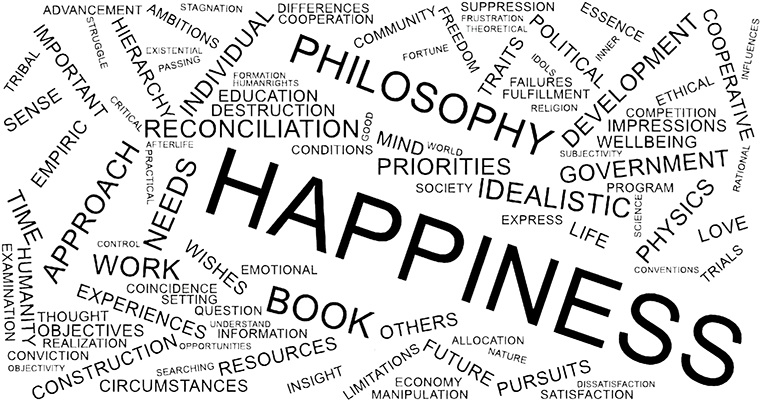
III. RESOURCES.
Like all my other books, Philosophy of Happiness is published by Palioxis Publishing. A complete online review version allows you to freely explore it. Introductions in various media, articles, essays, quotes, and poems help you ease your way into its subject matters. They are centrally referenced and accessible free of charge through the Resources section. You can listen to an audio version of the entire book free of charge on this site or the Philosophy of Happiness YouTube Channel. The audio book is divided by chapter, with links to respective free downloads of print book chapters in PDF format from PhilPapers. The book is also offered for purchase in paper print, hardbound and in a two-volume paperback edition, as well as in Kindle, Apple Books, Nook, Kobo, and Google e-book versions. For more information on these options, click here or the yellow banner above.
IV. TABLE OF CONTENTS
This Table of Contents is excerpted from the Philosophy of Happiness book. A PDF version is available in 2.a) of the Resources section or on PhilPapers.
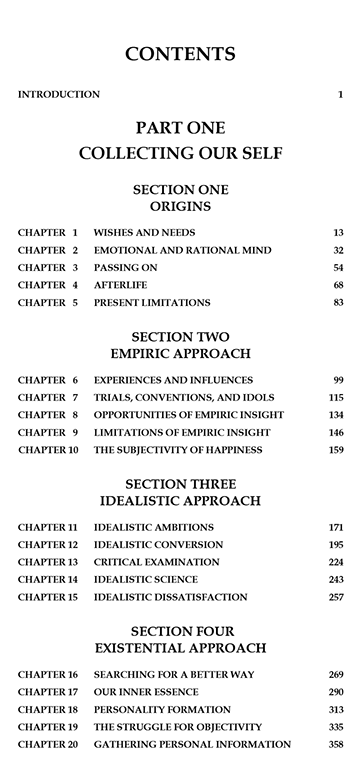
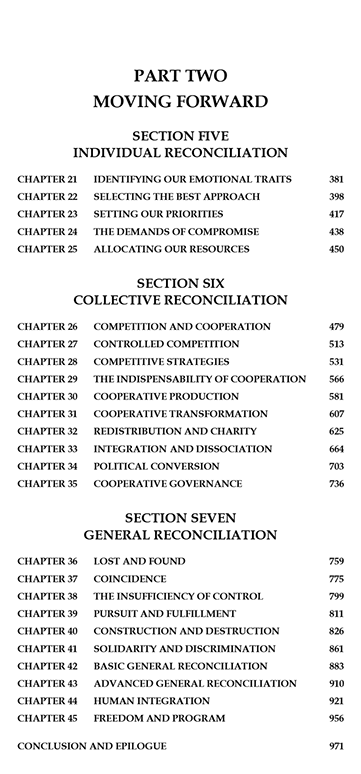
© 2013-2024 BY MARTIN JANELLO


